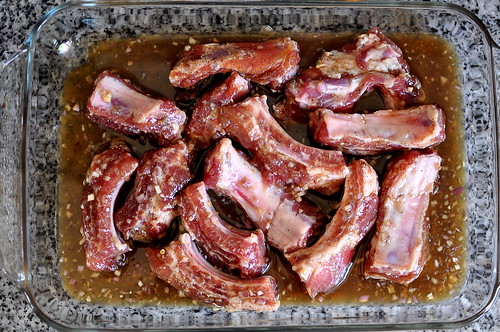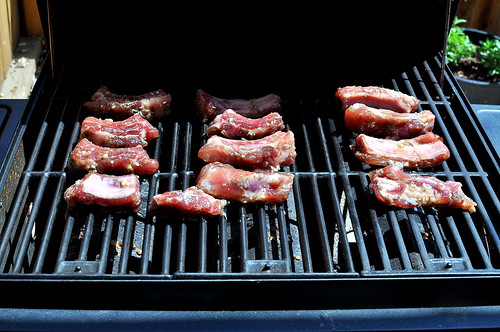One of the perks of having a mother who works for a meat distribution company are the random acts of kindness meatiness that occur from time to time. I love it when Mom surprises me with pounds of jumbo shrimp, bags of frozen chicken fingers, or most recently, racks of baby back ribs. With Memorial Day, the official start of the summer grilling season, around the corner, the timing could not have been any more perfect. These racks o’ ribs were destined to meet the heat, Vietnamese-style.
Sườn nướng was a mealtime staple growing up. Not only was it served often on weeknights for dinner, but it also made regular appearances at beachside family gatherings—La Jolla Shores, represent. The ease of prepping and cooking the ribs, as well as their intrinsic deliciousness, made them a standby for every occasion.
Comprised of just five ingredients—fish sauce, sugar, salt, black pepper, and shallots—this easy marinade treats pork to a sweet, salty, and wholly umami bath. Soaked overnight, then grilled over hot flames, the ribs’ exterior caramelizes beautifully, while the innards remain tender and flavorful.
The recipe below produces ribs that are savory enough to pair with a heap of rice, the Vietnamese way, but for those looking to eat their meat straight up, ease up some on the fish sauce and salt.
According to Mom, this is the best marinade ever. And she’s absolutely right.
- 2 to 3 pounds pork ribs, separated
- 2 large shallots, finely minced
- 4 ounces fish sauce (approximately 1/2 cup)
- 1/4 teaspoon salt
- 1 teaspoon black pepper
- 5 ounces granulated sugar (approximately 1/3 cup)
To prepare the marinade, whisk together the shallots, fish sauce, salt, pepper, and sugar in a medium-size bowl. Transfer the marinade to a gallon-size Ziploc bag, along with the ribs, and let the meat and marinade marry in the refrigerator overnight.
Let the ribs stand at room temperature for 30 minutes before grilling. Over medium-high flames, grill the ribs on both sides until slightly charred and fully cooked through, approximately 6 to 10 minutes per side. Optional: brush the ribs with leftover marinade.
Once the ribs are fully cooked, transfer to a serving platter and let rest for 5 minutes.
Serve over steamed white rice.
Serves 3 to 4.
More delightful Vietnamese recipes on Gastronomy:
- Bánh Bột Lọc – Clear Shrimp and Pork Dumplings
- Bánh Cuốn – Vietnamese Rice Crepes with Ground Pork and Mushrooms
- Bánh Giò – Minced Pork and Rice Dumplings
- Bánh Mì Tôm Chiên – Shrimp Toasts
- Bắp Xào Tôm Bơ – Vietnamese Sauteed Corn with Dried Shrimp, Scallions, and Butter
- Bò Bía – Vietnamese Jicama, Carrot, Chinese Sausage, Egg, and Dried Shrimp Rolls
- Bò Kho – Vietnamese Beef Stew
- Bún Riêu Cua – Vietnamese Crab and Tomato Soup
- Cà Dê Nướng – Roasted Eggplant with Soy Sauce and Chilies
- Cà Ri Gà – Vietnamese Chicken Curry
- Canh Chua Chay – Vegetarian Sour Soup
- Chả Giò – Vietnamese Egg Rolls
- Cháo Chả – Porridge with Braised Pork Sausage
- Cơm Chiên – Vietnamese Fried Rice
- Gỏi Cuốn – Vietnamese Pork and Shrimp Rolls with Hoisin Dipping Sauce
- Hủ Tiếu Mì – Vietnamese Pork Noodle Soup
- Mì Cà Ri Gà – Chicken Curry with Fresh Egg Noodles
- Mom’s Lollipop Fried Chicken
- Not Your Grandma’s Bánh Chưng
- Nui Lòng – Grandpa’s Spaghetti with Offal
- Nước Chấm – Vietnamese Fish Sauce Vinaigrette
- Nước Chấm Chay – Vegetarian Vietnamese Dipping Sauce
- Pasta with Eggs and Pork Floss
- Phở Bò – Vietnamese Beef Noodle Soup
- Phở Chay – Vegetarian Phở
- Thịt Bò Xào Hành Tây – Vietnamese Stir-Fried Beef with Onions
- Thịt Kho – Caramelized Braised Pork and Eggs
- Thịt Nướng – Vietnamese Grilled Pork
- Vietnamese Chicken Curry Pot Pie
- Đậu Hũ Kho – Braised Tofu with Mushrooms and Tomatoes
- Đậu Hủ Xả Ớt – Fried Tofu with Chilies and Lemongrass





Ooh, I would be all over these! You are so lucky to get such meaty (ha ha) gifts!
So you don’t have to boil ribs beforehand ? I love the recipe! Will have to try it out soon:)
Faye – Absolutely no boiling necessary. Baby backs cook up quickly and tenderly over a grill. I hope you love the marinade as much as we do!
YUM! We make something similar but broiling them since no grill currently.
Had to add minced garlic and red pepper flakes along with cucumber slices and a side of garlic chili sauce. We now have the “Itis.” Delish.
We just made these for dinner and they were amazing! We will definitely be making them again with friends. Though they’ll be tough to share!
If I don’t own a BBQ, can I do this in the frying pan then stick it into the oven? If so at what temp and for how long please
I’ve been eyeing this recipe for a while now but now that I’m about to make it, 5oz can’t be approx 1/3 cup if 4oz is approx 1/2.
Lane – the measurements are correct. One is a liquid measurement, while the other is not. I hope this turned out well!
4 oz is less than 5 oz
1/2 cup is more than 1/3 cup
measurement is definitely incorrect
Ya all be wrong. 🙂 And the recipe look phenomenal.
Lane and Linda:
As stated this is a liquid vs dry measurement thing, the missing tidbit is that “cups” is a volumetric measurement. Volumetric measurements can’t be compared like weigh measurements can because the density of what is being volumetrically measured isn’t accounted for.
A simple but extreme faux example would be (not accurate numbers) the following recipe:
Cotton Candy Water
—————————————
2 oz Water, cold (~ 1/4 cup)
1 oz Cotton Candy (~ 5 cups)
Gastronomer:
I would agree with others that your numbers are slightly off. A real simple way to get fairly accurate conversions is to go to the old legacy SR-style nutritional database (currently only in a broken-up CSV format) found at https://fdc.nal.usda.gov/download-datasets.html . Look in food.csv for sugar and note its fdc_id, 169655. Now look in food_portion.csv for that fdc_id and you will see for Sugar, Granulated it is roughly 200 g for 1 cup. Using the standard rounded up value of 1 oz = 30 g, 5 oz is equal to 150 g. With 200 g = 1 cup, 150 g would be roughly 3/4 cup.
These are calculated numbers and therefore may have variations depending on many factors including the environment. You could verify you numbers with a scale and no one could complain. Simple measure a 1/3 cup and weigh it. If it’s 5 oz or 150 g you were right, if it’s only ~ 66 g then you will know it’s off.
BTW OP, did you measure this via weight or volume when you made this?
Note for all: The “All Foods” Access database can be setup to allow the same as a query asking for which ingredient to search for each time it is run. Helpful if you wanted to know things like “How much fat does an avocado contain?” or “How much potassium is in 55 g of a banana?” or “What is the average amount of usable diced onion while I get out of the average medium onion?” It’s all in there.
Thanks for sharing the recipe. Can I cook the ribs in the oven? If yes, what temperature and for how long?
I’m sure you can, Jeannie. Here are Martha Stewart’s instructions:
Larger, fattier ribs need to be cooked longer than baby backs. Shoot for around 2 hours at 350 degrees if the ribs are uncovered.If wrapped in foil, the ribs can go for up to 3 hours at 300°F degrees, or crank the oven up to 400 degrees for a briefer baking time—1.5 to 2 hours.